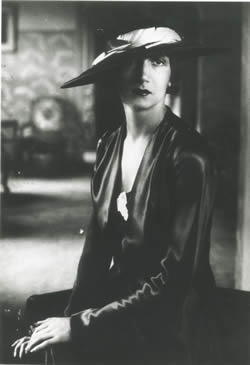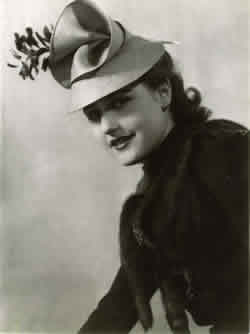










|
Search our Archives: » Home» History » Holidays » Humor » Places » Thought » Opinion & Society » Writings » Customs » Misc. |
Nazi Chic? Fashioning Women in the Third Reich By Dr. Irene Guenther It is 1943 at the infamous camp of Auschwitz. Twenty-three young women have been assigned to the "sewing room" detail, located at the camp's Stabsgebaüde where many of the SS female guards live. This clothing design and tailoring studio was established at the urging of the wife of Rudolf Höss, the feared commandant of the Auschwitz concentration camp. Frau Höss has been making personal use of free prisoner labor. Some time ago, an attic in the Höss villa was transformed into a studio, where two Jewish female inmates design and sew clothing for the commandant's family. The materials usually come from "Canada," meaning the warehouse filled with the belongings of Jews who are sent directly to the gas chambers. Other inmates work to supply the Höss family with luxury food items, as well as the finest leather shoes, silk lingerie, and suits – almost all formerly owned by Jews. Their house, filled with the finest furniture and overflowing closets, is surrounded by a "flower paradise" that is tended to by Auschwitz inmates. Frau Höss has everything and anything she wants and is heard to exclaim happily, "Here I will live and die." The Höss villa is located so close to the camp's "torture room" that the inmates' screams occasionally disturb the commandant during his afternoon nap. Because of mounting resentment and gossip by some camp employees about the Höss' prisoner-seamstresses, a design and tailoring shop is opened on the concentration camp's grounds. Frau Höss hopes that this will curtail the jealousy fueling the criticism. Now, more people can take advantage of the inmates' slave labor and fashioning talents. The purpose of the Auschwitz clothing studio is to produce extensive and stylish wardrobes for the wives of SS officers and the camp's female SS guards. Altogether, there are usually some twenty prisoners who toil in the workshop as designer-seamstresses. Each inmate has to produce two custom-made dresses per week. Every Saturday, exactly at noon, SS officials come to the studio to pick up their wives' and mistresses' new fashions. Orders consist of beautiful everyday clothes and lingerie, as well as exquisite evening gowns that will be worn to Nazi Party celebrations and SS social events. Sometimes, when the women are especially pleased with the clothing sewn for them that week, the inmates of the tailoring workshop are rewarded with an additional piece of bread as part of their meager food allotment. One SS female camp guard is so enthralled with the fashions the prisoners are producing that she announces to them, "When the war is over, I am going to open a large dressmaking studio with you in Berlin. I never knew that Jewesses could work, let alone, so beautifully." 
Surrounded by the unspeakable cruelty of Auschwitz, of which she plays an official and integral part, the guard's utterance resounds with inanity. Jews, who at one time were deemed too degenerate, too despicable to manufacture clothing for Aryan Germans and so were purged from the German fashion industry, are now feverishly sewing clothes for Nazi women. Equally inane, most of the female inmates, including those assigned to the design and tailoring studio, will not survive the genocide of the Third Reich. When Frau Höss is discovered after the war, hiding in an abandoned sugar factory, she is found amidst astonishingly large amounts of the finest hand-tailored clothes and furs, all sewn or once owned by Auschwitz's dead. The war is two years old; the year is 1941. A twenty-three year old German woman by the name of Ursula Schewe has just received her master's certification in fashion design and tailoring from the respected fashion school in Munich, the Meisterschule für Mode. She decides in the same year, despite the increasingly critical material shortages, to return to her hometown of Berlin and open her own fashion salon, the "Modewerkstatten." Surprisingly, in light of the difficult wartime circumstances, her shop does very well, and she is soon able to hire two apprentices and three salesclerks. The textiles that she uses for her fashion creations come from her own personal supply or through the redemption of ration coupons. In the following two years, Berlin comes under heavy fire from Allied air attacks. Streets are being reduced to rubble; houses and buildings are badly damaged. Yet, remarkably, Schewe's studio remains untouched. Equally astonishing, orders keep flowing into the Modewerkstätten. Schewe believes that business is so good largely because "it is personally important in such grim, war-related circumstances to own at least one nice, well-sewn garment." Women want to remain fashionable, even during the war. In April 1945, Soviet troops begin their massive attack on Berlin. With few troops left to defend the capital city, the Third Reich crumbles within three weeks. Germany unconditionally surrenders to Allied forces, and the horrific world war in Europe is finally over. Soon thereafter, the victorious Russian occupiers requisition Schewe's property. But, once again, Schewe is lucky. While rapes of German women occur on a daily basis, and most Berliners are doing without even the most minimum of necessities, like food or water, the Russians discover that Schewe and her employees can sew very well.
Soviet troops stationed in Berlin urgently desire someone who can repair their torn and dirty uniforms; particularly, officers' clothes require restoration. After all, the victors should look better than the vanquished. Sometimes, the garments have to be completely resewn because of their total state of disrepair. Mostly, though, buttons should be replaced and the uniform jackets' ragged epaulets need new cardboard inserted into the greatly tattered material. Rather than being forced to evacuate, Schewe is allowed to remain as the sole occupant of her building. Additionally, so that she and her employees can iron the mounds of Russian uniforms that are piling up, Schewe is given an extra ration of coal from the Soviet occupiers to counter the constant power stoppages that Berlin is experiencing. In no time at all, the wives of Soviet officers hear about Schewe and her Werkstätten clothing salon. She is inundated with orders from Russian women who want to be dressed in the latest styles. "Fashion," Schewe claims, "is neutral." "In fact," she insists, "fashion has absolutely nothing to do with politics!"
During the Third Reich, women's clothing and image became a site of contentious debate. Clothing, which the Nazis hoped would serve as a visible sign of inclusion into – or exclusion from – the Volksgemeinschaft, the German national community, instead became a symbol of discord between the government and much of its female citizenry.
"Nazi Chic? Fashioning Women in the Third Reich", the prize-winning book by historian Dr. Irene Guenther, explores attempts by the Nazi state to construct a female appearance that would mirror official gender ideology, uphold and extend its anti-Semitic policies, promote a German cultural victory on the fashion runways of Europe, and support plans for a Nazi-controlled European fashion industry. Within this larger story of fashioning German women, however, are many smaller ones, as the opening revealing examples illustrate: tales of economic greed and political machinations; of ideological hyperbole, cultural contestations, and the manufacture of illusion; of gender fashioning and class conflict; of exclusive high fashion salons and destitute Jewish ghettos; of world war, home fronts, and concentration camps. Contrary to Frau Schewe's claim, fashion in the Third Reich had everything to do with politics.

(All of the fashions shown in the photos were created during the Third Reich; however, the designers of these fashions have, thus far, been untraceable). |
|

To the Current Index Page |

Write Us |

To the Big Archives Index Page |